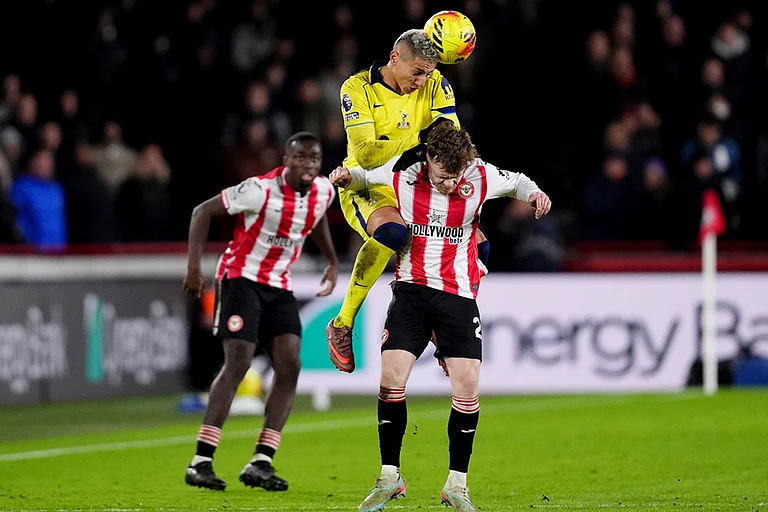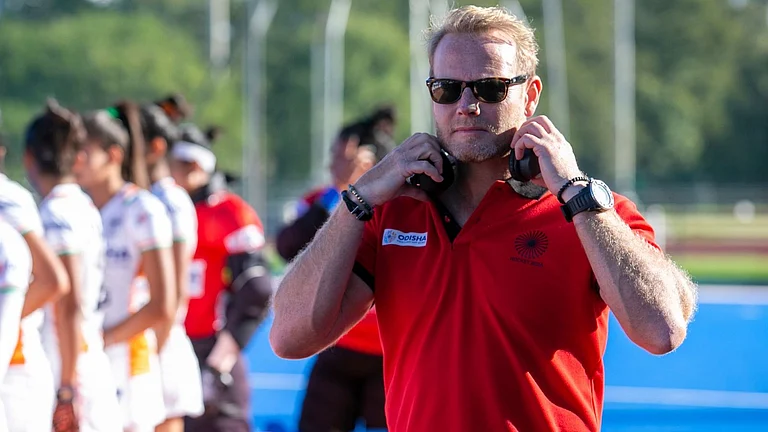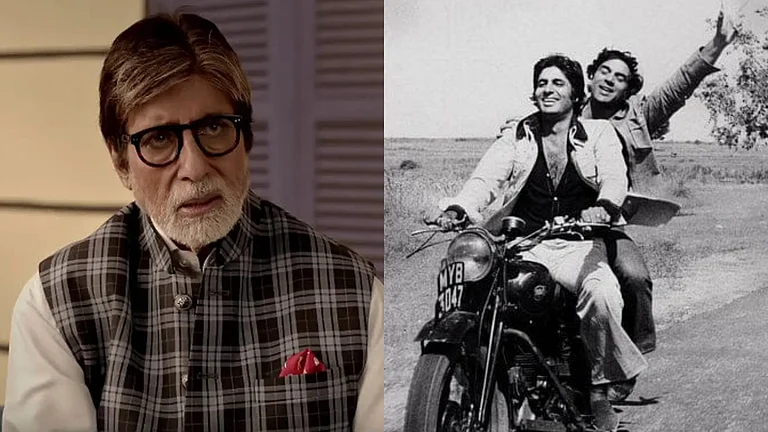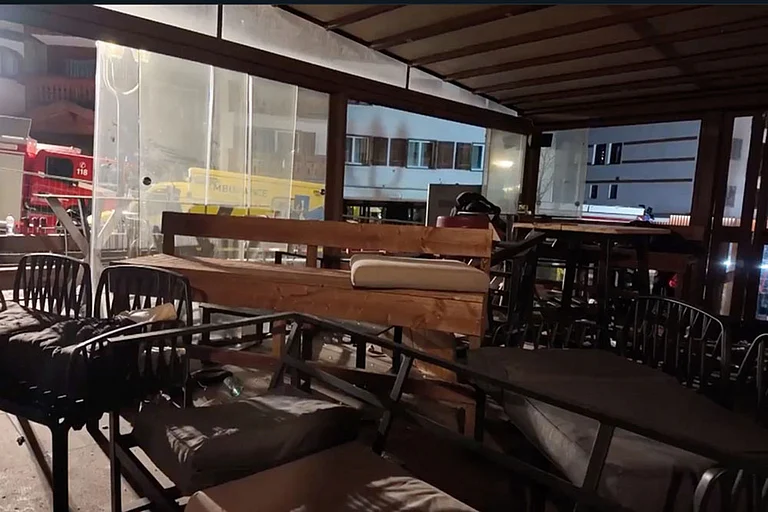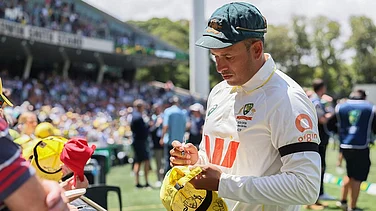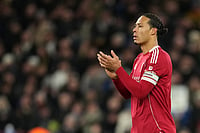Renu Malik (18) appears poised in her tight-fit blue shorts and purple t-shirt as the referee blows the whistle. The winter sun shines gently on the traditional mud wrestling turf. With each twist, hold and drop, Malik demonstrates her strength, speed and technical prowess. Although it is a practice match, it is hard to ignore the intense grit and focus on her face as she jostles with her opponent, a budding wrestler herself, in a bid to pin her down with a knockout move.
While most of the other girls assembled here have a buzz cut or a crew cut, Malik sports a short bob cut. The cropped hair may be a choice of convenience, but it is also a statement in a society where a young woman’s worth is often defined by her feminine physical attributes, among them skin tone and length of hair, and patriarchal norms of honour attached to their clothes and marriage choices. “She has all her life to grow her hair,” says a proud Paleram Malik, her father, beaming as he watches her perform. It does not bother him or his daughter that some people in the past have mockingly referred to her as a ‘ladka’ (boy).
But all this is irrelevant in the ring where the stout and physically superior Renu, the sweat on her face glistening under the sun, outmuscles and outmanoeuvres her opponent under the watchful eyes of her coach. The mostly male spectators cheer both contestants. When the bout ends, the referee declares the winner, raising her arm in the air. The bout was preceded by an indoor training session. It has been a long day of exercise for the young girl.
The spectacle defies the popular perception of one of India’s most patriarchal states—a bunch of sturdy young girls with cropped hair in skin-fit gear sweat it out against each other on a traditional mud wrestling turf, as young boys and the elderly of the village look on from the sides, largely in encouragement. From a distance, it is difficult to tell the onlooking boys from the girls on the field. In a deeply male-dominated society like Haryana’s, this might seem like delusional. However, in this dusty setting—a basic rural stadium in Kasandi village in Sonepat—this is a reality, and it’s growing popular.
Among the most promising female wrestlers here, Malik started out as a kho-kho player, representing Haryana at the Under-17 and junior national levels, before she made the jump to pehalwani (wrestling). An individual player sport would give her a better chance of shining at a competitive level than a team sport, she reasons. “In a team sport, if one player is injured, the entire team suffers. In wrestling, I can play on my own strength,” she says, reflecting her ambition.
Malik has her father’s unflinching support. A Jat farmer, Paleram owns around three killas of land (15 bighas) and two buffaloes. Himself a desi akhara wrestler in his youth, Paleram inspired his daughter to take up wrestling. The sport, a male domain, has not only provided thousands of youngsters in the state an opportunity to achieve glory but also a source of employment and, especially for women, a gateway to stepping out of their homes for education. “She will get a job. She will succeed in life… free herself from the drudgery of picking gobar (dung). What else is there to do in the countryside?” quips Paleram.
She has plenty of inspiration in the likes of fellow Haryanvi achiever Geeta Phogat, who was appointed deputy superintendent of police by the state government after her medal win in international wrestling. Her wrestler sister Babita Phogat had also been directly recruited in the state police force as sub-inspector, but she quit the job to pursue a political career with the Bharatiya Janata Party in 2019.

Malik and the others have two three-hour sessions every day, with the first one starting as early as 5 am. They usually practise at the modestly equipped indoor academy run in the village by a former wrestler Sandeep Bhanwara, whose career was cut short after suffering an arm injury some years ago. As coach, his goal is now to “prepare Olympic-level players”.
Both boys and girls train under Sandeep—out of the 60 wrestlers at the academy, around 12–15 are girls. The number of girls is constantly on the rise, he says.
Himanshi Bhanwara, 14, is among them. She says she took to the sport to bring glory to her village. But for young girls like her, it is also about pursuing individual freedom and choices. In this consticting space, they are torchbearers of change in mindsets, albeit at a niche level. The young women wrestlers acknowledge the privilege the sport has provided them. Besides the lure of decent prize money, fame and a career through the state’s incentivised sports policy, the sport has also expanded their engagement with society. “Girls who are not into wrestling do not enjoy the freedom as they mostly stay home,” says Himanshi.
Two kilometres away from Kasandi, Malik’s modest room is decorated with trophies and more than a dozen medals she has won in kho-kho and wrestling. Winner of a gold medal in freestyle wrestling at the under-15 level, Renu is looking forward to the national open ranking tournament scheduled in February. She aspires to go international like her idol Vinesh Phogat, the first Indian woman wrestler to win a gold medal at both the Asian and the Commonwealth games. Most recently, Vinesh was among a group of acclaimed wrestlers who gathered at Jantar Mantar in Delhi and accused the head of Wrestling Federation of India of harassment of players. The protest has a huge resonance among the girls in Kasandi.
Malik’s mother Shakuntala greets me with her face partially covered, as is the custom here. Like Paleram, who makes two trips to the training academy daily to drop and pick Malik, Shakuntala is putting in extra hours at home to make her daughter’s life easier. “I ensure that my daughter is free to focus on wrestling. I prepare all the nutrition she needs… and feed her churma and halwa whenever she desires,” says Shakuntala. Even though the couple also has a son, they feel their daughter is meant for greater things. “We don’t discriminate between the two. Our girl is gifted,” says Paleram.
Those familiar with Haryana’s gender dynamics say that the participation of women in sports, especially a hyper-masculine one such as wrestling, is only growing. While the 2016 Bollywood flick Dangal, starring Aamir Khan, drew attention towards it for the national audience, in Haryana the seeds were sown much earlier. What began as entertainment for royal families, wrestling today has emerged as a robust professional sport.
Wrestling has long been a popular sport for men in rural India, especially Haryana, with dangals (bouts of wrestling) being part of cultural expression. This, along with a rich traditional diet and agrarian work ethic, makes it accessible for rural women, opine experts.
Among the first women to take to wrestling in the state was the daughter of Chandgi Ram, the renowned wrestler who won a gold in the 1970 Asian Games. Ram started an akhara (a wrestling school) in Delhi in the mid-1990s and trained wrestlers including his daughter Sonika Kaliraman, who competed internationally before she married and moved abroad. It was at Ram’s akhara that Mahavir Singh Phogat, the protagonist played by Aamir Khan in Dangal, trained his daughters, points out Rupal Oza, professor of Women and Gender Studies at Hunter College in New York. Geeta Phogat became the first Indian woman to win a gold in freestyle at the 2010 Commonwealth Games, inspiring thousands of women in Haryana. “Parents of women wrestlers support their daughters hoping that their success will eventually fetch fame, job and izzat (respect). These families are relatively poor, with perhaps a bit of land, but struggling to make ends meet. It is these families from where the majority of women wrestlers come,” noted Oza in a 2019 article published in a feminist journal.

Manisha Sangwan, a Congress leader from Haryana, says that the erstwhile Bhupinder Hooda government played a significant role in promoting the sport much before Dangal fame through the ‘padhak lao, pad pao’ policy under which successful wrestlers were rewarded with class 1 or 2 government jobs. There was a spurt in the number of wrestlers in the decade before 2016, she Sangwan.
While the charm of international glory and winning medals for the country and state inspires many young wrestlers, employment opportunities are the major driving force. Rakesh Bhanwara, a local teacher, says that most of the wrestlers here come from poor families. While the lucky ones get selected for government jobs, the others have to make do with employment at the Bhagat Phool Singh Medical College for Women in Khanpur, located around 4 km away. For a farming rich state, Haryana is also dealing with rampant unemployment. According to the Centre for Monitoring Indian Economy, Haryana had the worst unemployment rate in the country at 37.4 percent as of December 2022.
Since 2017, when he lost his wife to illness, petty mechanic Ashok Kumar Bhanwara has played the role of both mother and father to his three children. While all three are wrestlers, Ashok has great expectations from his two daughters, Tanu and Tabbu. The family is landless and their financial situation is precarious. Success in wrestling is a means to change their financial condition. For want of proper guidance, he could not make it in wrestling. But he is determined to support his children. “One day they will find their destiny. Now girls are no less than boys in these competitions,” says Ashok.
Tanu, 19, has won a silver medal at the national cadet tournament, while Tabbu has a gold medal at the state level. They dream of nothing less than an Olympic medal. Before Sakshi Malik won a bronze for India in the 2016 Olympics in freestyle, the Bhanwara sisters did not even know of the international event.
While I found that parents are largely supportive of their daughters taking up wrestling, we cannot ignore the larger context where sexist norms still dictate roles and expectations of a woman. She is at best expected to fill in the place of a son. “Yeh meri ladki nahi, ladka hai (This is not my daughter but son)” being a common refrain of virtue.
Initially, people tried to dissuade Ashok from sending his daughters to the akhara. “‘She’s a girl. Something adverse will happen to her,’ they would say. Our father backed us and said, ‘My daughters are no less than boys.’ They will take care of themselves,” says Tanu. The two girls train at the Subash Chandra Bose Sports Academy in Madina, where Olympian and two-time sub-junior world champion wrestler Sonam Malik hails from.

Not just emotional support, building a career in wrestling also requires substantial financial investment, especially in terms of diet, training and coaching, even though there is no shortage of guidance for newcomers. “It takes all four corners of a house to make a wrtestler. You spend money to prepare the wrestler and often fall into debt. When the wrestler wins and secures a job, she starts paying back,” says Tanu. She is grateful to the sport for granting her an avenue to step out of home and become confident. “The other girls are oftne still very shy. They don’t even speak out. Wresting teaches us to open up and speak freely. We become like a khiladi (player), ” says Tanu.
Sandeep Arya, the sarpanch of Kasandi, says such is the ‘craze’ for wrestling now that people are even selling their land to fund their daughters’ training facilities. Good academies are expensive and the government does not provide special support in rural areas, rues Arya.
While the preference for a male child still persists, with women coming up and excelling in wrestling, people feel the girl can play the role of a boy and fetch them glory and monetary benefits, explains Arya.
In many instances, parents do not have money to invest on the child and they rely heavily on big sponsors, says Dipika Malik, 22, a wrestling coach and referee. “Earlier we had the ghee-doodh ki pehalwani (wrestling fed on milk and clarified butter). Now it is a must to consume protein supplements. Every food item is adulterated,” says Dipika, who hails from the village of Olympic medal winner Yogeshwar Dutt.
Dipika says that as wrestling becomes more popular among rural girls, it is also slowly changing social ideas about how boys and girls should interact. Neetu, a Dalit wrestler and winner of three medals, attests to this view. She says her father is comfortable with the idea that she trains together with boys. “Sometimes, when there are no girls around, we even jostle in the ring with boys. There is no rok tok (objection),” says Neetu.
Coach Sandeep says there has not been any untoward incident in his academy so far. However, the spectre of sexual violence and harassment is always looming there. He cautions parents of girls who accompany them. “They have to reach early morning and leave in the evening. I ask them to not travel alone,” he says.
Four wrestlers, two of them girls, from hiss academy have been selected for the upcoming Khelo India Youth Games in Bhopal. Kasandi takes pride in its female wrestlers. Baljeet Bhanwara, a village elder, says: “All girls who have gone international in wrestling are from rural areas of Haryana. Cities don’t give their girls the required time. We ensure our girls get what it takes to excel.”
Jagmati Sangwan, a leftist–feminist activist, herself an international volley ball player, says the inclusion of women in wrestling in this rural space challenges stereotypes of beauty and femininity. However, she feels more needs to be done to improve the infrastructure. “Girls in wrestling are mostly from rural areas. But there are no facilities for them near their villages. The families need to find safe rented apartments for the girls in towns and cities. The entire time the parents worry about the safety of their girls,” says Sangwan.
Devika Siwach, an activist from Rohtak, a major wrestling belt in Haryana, says that despite the persisting challenges, including patriarchy, it is a remarkable feat that parents from rural Haryana are supporting their daughters to wrestle. “Anyone can send their child for higher education. But to train her for wrestling in an atmosphere where girls are not allowed to venture out on their own and their every move is under surveillance, and a hundred questions asked of parents… that is something else,” she says.
Activist Sunil Jaglan, who started the famous ‘selfie with daughter’ campaign in the state, however, says the larger patriarchal perception about women and sports persists. Only the ultra-achievers are hailed, he stresses. Jaglan points out that the prize money for dangals organised for women is much less than that for male events, which are also more frequent. “It is still not that easy for someone to send their daughter for wrestling. If a couple has the option of both a boy and a girl, they usually prefer the son when it comes to a wrestling career,” says Jaglan
A telling, illustrative comment on a state where the sex ratio at birth is still among the worst, though it has improved over the years, touching 916 in mid-2022. With rampant gender-based oppression and male chauvinism, as elsewhere in the country, it is normalised for women to stay behind a purdah and wear loose-fitting clothes. Not only does the state fare poorly in crimes against women, khap panchayats, a traditional collective of clans, have also been notorious for issuing oppressive diktats. For instance, in 2013 a khap in Jhajjar ruled that girls above 10 not be allowed to wear jeans. In 2018, another khap banned mobile phones to prevent women from eloping. There are numerous instances of ‘honour’ killings in which young couples have been killed for marrying a man of their choice, for example, Manoj and Babli from Kaithal, who were killed in 2007.
(This appeared in the print edition as "WRESTLING Their Way to Freedom")
Omar Rashid in Sonepat







